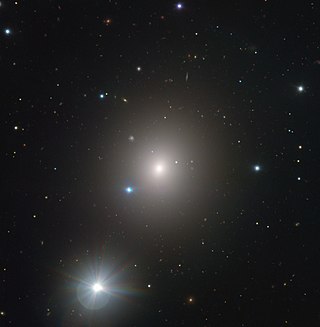
NGC 1404 is an elliptical galaxy in the Southern constellation Eridanus. It was discovered on November 28, 1837, by the astronomer John Herschel. Based on the tip of the red-giant branch distance indicator, it lies at a distance of approximately 60 million light-years from the Milky Way. It is one of the brightest members of the Fornax Cluster.

NGC 3268 is an elliptical galaxy in the constellation Antlia. It is a member of the Antlia Cluster, which lies about 40.7 megaparsecs away. It was discovered on April 18, 1835 by the astronomer John Herschel.

NGC 3258 is an elliptical galaxy in the constellation Antlia. It is a member of the Antlia Cluster, which lies about 40.7 megaparsecs away. It was discovered on May 2, 1834 by John Herschel.

NGC 78 is a pair of galaxies in the constellation Pisces. NGC 78A, which is the more southern galaxy, is a barred spiral galaxy. NGC 78B, which is the more northern galaxy, is an elliptical galaxy. Although the designations NGC 78A and 78B are used today, the designation NGC 78 was formerly used mainly for the northern galaxy.

NGC 4147 is the New General Catalogue identifier for a globular cluster of stars in the northern constellation of Coma Berenices. It was discovered by English astronomer William Herschel on March 14, 1784, who described it as "very bright, pretty large, gradually brighter in the middle". With an apparent visual magnitude of 10.7, it is located around 60,000 light years away from the Sun at a relatively high galactic latitude of 77.2°.

NGC 5308 is an edge-on lenticular galaxy in the constellation of Ursa Major. It was discovered on 19 March 1790 by William Herschel. It was described by John Louis Emil Dreyer as "bright, pretty large" when he compiled the New General Catalogue. A small, irregular galaxy near NGC 5308 has been given the designation LEDA 2802348.
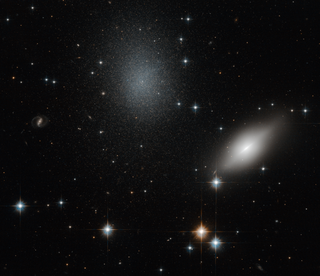
NGC 5011 is an elliptical galaxy in the constellation of Centaurus. It was discovered on 3 June 1834 by John Herschel. It was described as "pretty bright, considerably small, round, among 4 stars" by John Louis Emil Dreyer, the compiler of the New General Catalogue.

NGC 5559 is a barred spiral galaxy, located 240 million light-years away in the constellation of Boötes. It was discovered on April 10, 1785, by the astronomer William Herschel.

NGC 6975, also known as NGC 6976, is a spiral galaxy in the constellation Aquarius. The object was discovered on 12 July 1864 by the German astronomer Albert Marth.

NGC 3402, also known as NGC 3411, is an elliptical galaxy in the constellation Hydra. The object was discovered on March 25, 1786 by German-British astronomer William Herschel. NGC 3402 is the largest galaxy in the eponymous NGC 3402 cluster.
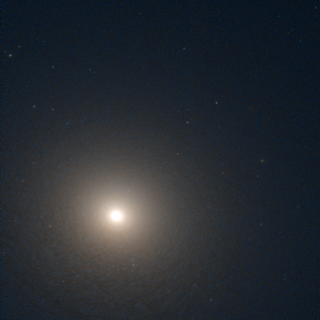
NGC 1400 is an elliptical galaxy in the constellation Eridanus. At a distance of 65 million light-years from Earth, it was discovered by John Herschel in 1786. It is a member of the NGC 1407 group, whose brightest member is NGC 1407. The NGC 1407 group is part of the Eridanus Cluster, a cluster of 200 galaxies.
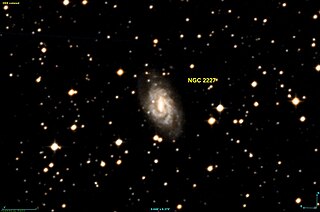
NGC 2227 is a barred spiral galaxy with a morphological type of SB(rs)c located in the direction of the Canis Major constellation. It was discovered on January 27, 1835, by John Herschel.
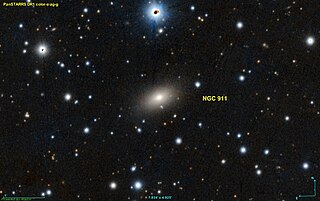
NGC 911 is an elliptical galaxy located in the constellation Andromeda about 258 million light years from the Milky Way. It was discovered by French astronomer Édouard Stephan in 1878. It is a member of the galaxy cluster Abell 347.

NGC 996 is an elliptical galaxy of the Hubble type E0 in the constellation Andromeda. It is estimated to be 210 million light years from the Milky Way and has a diameter of approximately 75,000 ly. The supernova SN 1996bq occurred in this galaxy. NGC 996 was discovered on December 7, 1871 by astronomer Édouard Stephan.

NGC 941 is an intermediate spiral galaxy in the constellation Cetus. It is an estimated 16.83 MPc from the Milky Way and has a diameter of approximately 55,000 light years. The galaxies NGC 926, NGC 934, NGC 936, NGC 955 are located in the same sky area. NGC 941 was discovered by the astronomer William Herschel on 6 January 1785.
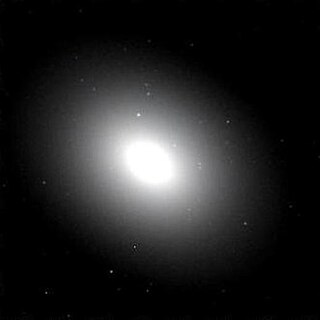
NGC 4365 is an elliptical galaxy located in the constellation Virgo. It was discovered by William Herschel on April 13, 1784.
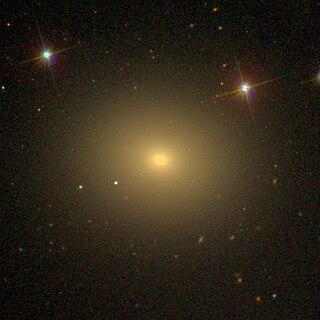
NGC 3608 is an elliptical galaxy located in the constellation Leo. It was discovered by William Herschel on March 14, 1784.

NGC 3254 is a spiral galaxy in the constellation Leo Minor. It was discovered on March 13, 1785, by the astronomer William Herschel. It is a member of the NGC 3254 Group of galaxies, which is a member of the Leo II Groups, a series of galaxies and galaxy clusters strung out from the right edge of the Virgo Supercluster.

NGC 677 is an elliptical galaxy located in the constellation Aries. It was discovered on September 25, 1886, by the astronomer Lewis A. Swift. It is located about 200 million light-years from Earth at the center of a rich galaxy cluster. It has a LINER nucleus.
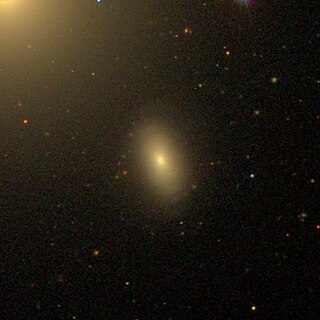
NGC 3605 is an elliptical galaxy located in the constellation Leo. It was discovered on March 14, 1784, by the astronomer William Herschel.




















